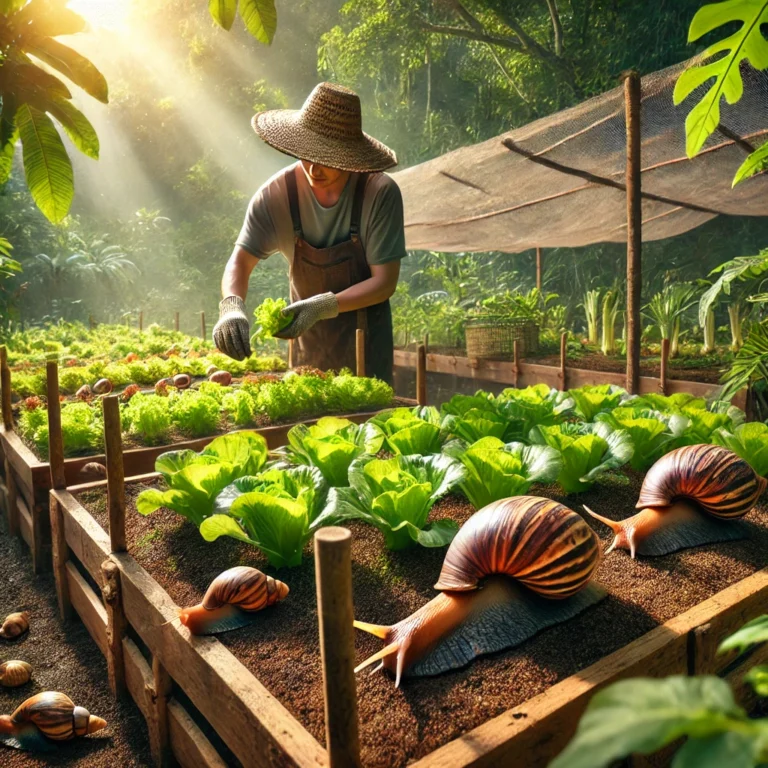Snail farming is one of the most underrated yet highly profitable agribusinesses, especially in the tropics. But here’s the big question: Are you really maximizing its potential? Many farmers struggle with slow growth, high mortality, and poor sales. If that sounds familiar, don’t worry—you’re not alone!
Let’s talk about how to make your snail farm thrive and ensure you’re not leaving money on the table. Whether you’re just starting or looking to scale up, these tips will help you get the best out of your snails.
1. Are You Rearing the Right Snail Species?
Not all snails are profitable for commercial farming! If you want the best snail species for farming, choosing the right one is crucial. In tropical regions, some species thrive better than others, leading to more profitable snail farming.
The Giant African Land Snail (Achatina achatina) is a popular choice because it grows fast and lays many eggs. Archachatina marginata is another great option, as it is meatier and highly valued in markets. If you want something easier to manage, Achatina fulica breeds quickly but is smaller in size.
Each species has its advantages, but selecting one that suits your farm’s climate and market demand is key. Some farmers mix species, but this requires careful management.
2. Is Your Snail Housing Helping or Hurting Your Farm?
Your snail farming housing setup plays a major role in your success. Poor housing leads to slow growth, disease outbreaks, and even mass deaths. If your snails are not growing well, check these factors.
Snails thrive in specific environmental conditions, so ensuring the best soil for snails is crucial. They need soft, nutrient-rich soil to burrow and lay eggs. Avoid sandy or stony soil as it affects shell formation. Also, snail farm setup should include protection from predators like ants, rats, and birds. Using snail farm pest control techniques such as fencing and mesh coverings can prevent major losses.
Do you use concrete pens, wooden boxes, or open-field systems? Each method has its pros and cons, and it’s important to find what works best for you.
What type of snail housing do you use? What has worked best for you? Drop a comment!
3. Are You Feeding Your Snails Right?
Feeding snails properly is the key to profitable snail farming. If you are wondering what to feed snails, it’s important to focus on high-nutrient foods that support healthy growth.
Snails thrive on leafy greens like pawpaw leaves, cocoyam leaves, waterleaf, and lettuce. They also enjoy fruits and vegetables such as bananas, cucumbers, pumpkins, and carrots. However, the most important part of a snail’s diet is calcium for snails, which helps with strong shell formation. You can provide this through eggshells, limestone, and bone meal.
Farmers who use a balanced feeding approach often see better results in growth rate and shell strength.What do you feed your snails?
Have you discovered any special diet that boosts growth? Let’s discuss!
4. Are You Managing Moisture Correctly
Snails require specific humidity levels to stay active and grow. Proper humidity control in snail farming is essential to prevent dehydration or fungal infections.
To maintain the best environment for snails, regularly mist their enclosure with clean, non-chlorinated water. However, be careful not to overwater, as a waterlogged environment can lead to bacterial infections. Farmers who master how to water snails and create a balanced environment see better survival rates.
5. Are Pests and Diseases Eating Into Your Profits?
Many farmers lose snails to predators and diseases. Snail farm pest control is crucial to prevent losses. Keeping out ants, rats, and birds using protective housing and natural barriers can help. Regular cleaning of snail enclosures also prevents fungal and bacterial infections.
Overcrowding increases stress levels and the spread of infections. Snails require space to grow, so it’s important to avoid cramming too many into one enclosure. If you’re experiencing high mortality rates, checking for snail farming diseases like shell damage, bacterial infections, and parasitic infestations is important.
6. Are You Harvesting at the Right Time?
One of the biggest mistakes in snail farming business is harvesting too early. Snails need time to reach their full size before they are ready for sale. Knowing when to harvest snails can impact your profit margins.
A good indicator of maturity is shell hardness—fully grown snails have a firm, hard shell. You can also weigh them to ensure they meet market standards. Keeping some mature snails for breeding ensures your farm remains productive. You can sell your snails fresh, dried, or processed at local and international markets.
Conclusion
Snail farming is one of the most promising agribusinesses in the tropics, but only if done right. Avoiding common snail farming mistakes and implementing the right strategies can increase productivity and profits.
✅ Are you facing any challenges in your snail farm?
✅ Do you have a winning strategy that’s working for you?
✅ Have you discovered a secret trick that makes your snails grow faster
Drop your thoughts in the comments! Let’s learn from each other and build successful snail farms together.
